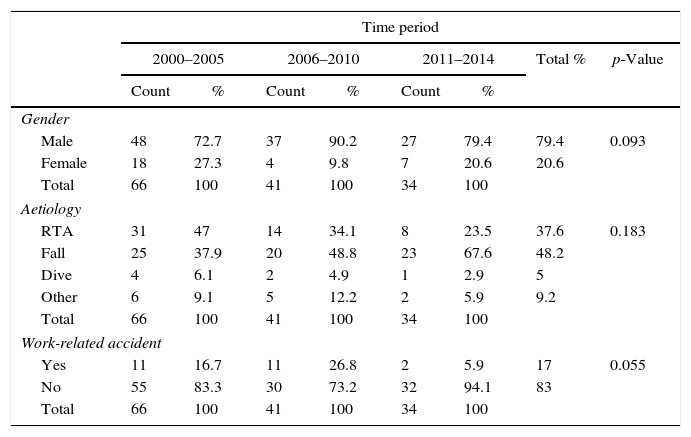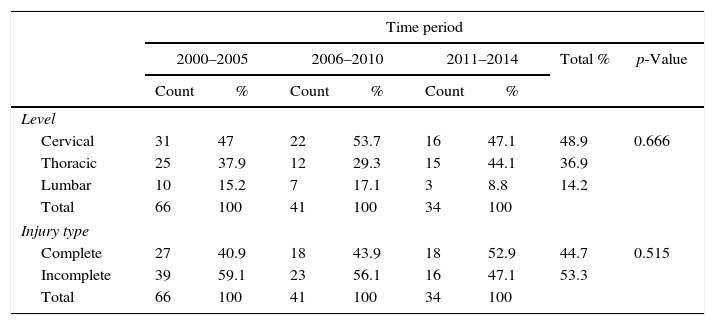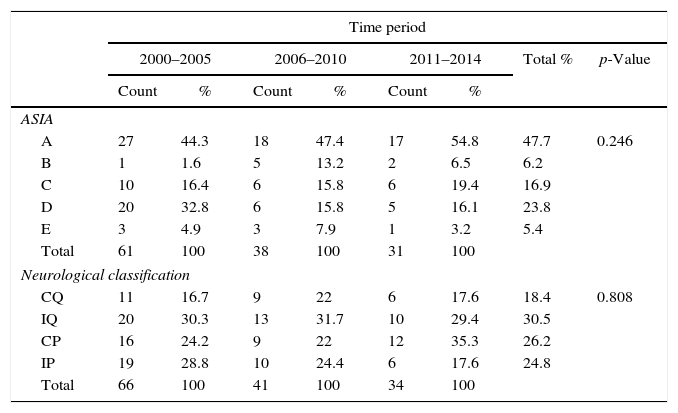To evaluate the epidemiological and clinical trends in acute traumatic spinal cord injuries.
Material and methodsA retrospective study was conducted of traumatic spinal cord injury patients in Gran Canaria (Canary Islands, Spain) from 2000 to 2014. Demographic and spinal injury severity trends were analysed by year of injury grouped into 3 periods: 2000–2005, 2006–2010, and 2011–2014.
ResultsThe sample included 141 patients. The mean incidence for the entire period was 12 cases/million/year. There was a decrease in cases in the second and third period. While the male/female ratio was 3.8/1 and was maintained in all periods, the mean patient age increased from 38.8 in 2000–2005 to 54.5 years in 2011–2004 (p<.05). Falls have been the leading cause of spinal cord injury (48.2%), followed by traffic accidents (37.6%). Falls have increased, especially in the older population. Incomplete tetraplegia has been the most prevalent group (30.5%). A vertebral fracture was suffered by 70.3% of all patients, with 93.2% of them requiring surgery.
ConclusionsThere has been a decrease in the incidence of traumatic spinal cord injury in recent years. The target population has changed, and the older population is currently the most affected. This reality suggests the need to change the local prevention campaigns for spinal cord injury in the elderly.
Determinar la tendencia de la incidencia del paciente con una lesión medular de origen traumático y describir las características epidemiológicas y clínicas de esta población.
Material y métodosSe ha realizado un estudio descriptivo retrospectivo de los pacientes que han sufrido una lesión medular de origen traumático en la isla de Gran Canaria (islas Canarias, España) desde el año 2000 al 2014. Para estudiar la tendencia se han dividido los pacientes en 3 periodos según el año de la lesión: 2000-2005, 2006-2010 y 2011-2014.
ResultadosEl número de casos ha sido de 141 pacientes. La incidencia media para todo el periodo ha sido de 12 casos/millón/año con una disminución de los casos en el segundo y tercer periodo. Mientras la relación hombre/mujer de 3,8/1 se ha mantenido, la edad media del paciente ha aumentado de 38,8 años entre el año 2000-5 a 54,5 años en el 2011-14 (p<0,05). La caída, que ha sido la principal causa de lesión medular (48,2%) seguida de los accidentes de tráfico (37,6%), ha aumentado especialmente en la población de mayor edad. La lesión incompleta ha predominado sobre la completa, siendo la tetraplejía incompleta el grupo más prevalente (30,5%). El 70,3% de los lesionados medulares tenían una fractura vertebral y de ellos han sido intervenidos quirúrgicamente el 93,2%.
ConclusionesEn los últimos años ha habido una disminución de la incidencia de la lesión medular de origen traumático con un cambio en la población diana, afectando principalmente a la población de mayor edad. Estos hallazgos muestran la necesidad de replantear las campañas de prevención local de la lesión medular en el anciano.
Article

If it is the first time you have accessed you can obtain your credentials by contacting Elsevier Spain in suscripciones@elsevier.com or by calling our Customer Service at902 88 87 40 if you are calling from Spain or at +34 932 418 800 (from 9 to 18h., GMT + 1) if you are calling outside of Spain.
If you already have your login data, please click here .
If you have forgotten your password you can you can recover it by clicking here and selecting the option ¿I have forgotten my password¿.












